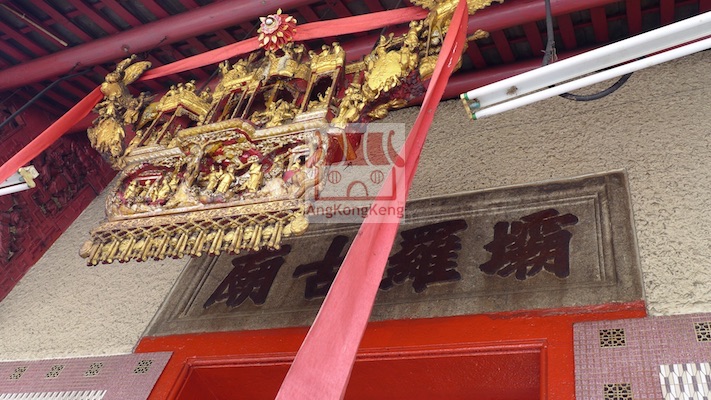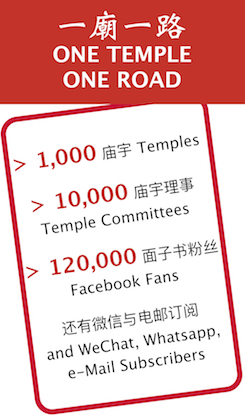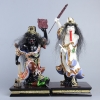点击此霹雳怡保坝罗古庙Perak Ipoh Paloh Khoo Miu以阅览更多庙的照片与资料。
点击此霹雳怡保坝罗古庙简史(中文)以阅览此文中文版。
Ipoh was originally known as Paloh, meaning tin mines, many of which were operated around Paloh more than a century ago, dating back to as early as the 19th Century.
As Paloh Khoo Miu worshipped the Real God of Tai Pak Koong(大伯公)it was also known as Ipoh Chinese Tai Pak Koong Temple among local residents.
The Paloh Khoo Miu witnessed the development of Paloh, particularly the early Chinese immigrants who overcame all sorts of difficulties and challenges for the past few centuries. With a history of 133 years till now, it blessed Ipoh residents all these years, with joss sticks burning unceasingly amid endless worshippers. The birthday of Da Bo Gong, which falls on the 16 of February of the Lunar calendar, was grandly celebrated annually with drama performances lasting a couple of days and nights to thank HIS blessings.
The God Spirit of Da Bo Gong was originally brought with burning joss sticks from the Da Bo Gong Temple in Hai Zhu Island, near Penang, 133 years ago in 1872, by Leong Fi(梁辉)(also known as Liang Bi Ru (梁碧如) whose native town was Mei Xian of China’ s Guangdong Province), a prominent miner, and others, settling HIM down in a small temple by the side of the Kinta River in Paloh. At that time, there were barges and small boats navigating between Paloh and Teluk Intan. With Tai Pak Koong sitting at the Old Temple offering blessings and protection, residents were safe both at home and in outings. They paid high tribute to HIM with devout homage.
Some two decades later, in 1894 (coincided with the Jia Wu Year of the Qing Dynasty's Emperor Guangxu), zealous local residents, led by Overseas Chinese leaders Leong Fi (梁辉) and Yau Tet Sin (姚德胜)(originated from Guangdong Province's Pingyuan County), applied to the British Government for a piece of land to build a temple. Upon approval and with strong support from Overseas Chinese leaders and local residents, the Paloh Old Temple was formally built at its present site.
In its earlier stage, the Old Temple did offer free medical consultations and medicines to local residents suffering from illnesses. The services were well supported and received by the locals. Besides, people having disputes with others came to Tai Pak Koong Temple for justice by proving their innocence. As such, the Old Temple was also a sacred place where local people resolved their differences and disputes.
All activities of the Temple ceased when the Japanese army invaded in 1941, with all its records, documents and photographs being destroyed by fire, regrettably leaving a blank in the Old Temple's history!
When the Japanese occupation ended after three years and eight months, responsible persons of the Old Temple elected Lau Pak Kuan(刘伯群), the then Overseas Chinese leader, as chairman of the Board of Governors, with Cheong Feng (张方) as secretary, and representatives from the four major provinces serving as board members. They were charged with the responsibilities of reviving activities of the temple, including its renovation and construction of a new performance stage, laying the foundation of its size today.
In 1951, the Paloh Khoo Miu’ s Board of Governors, in a bid to boost local Chinese education, donated the adjacent vacant land to the Perak Chinese Girls Primary School for the erection of a three-storey classroom building to accommodate more pupils of Chinese origin.
When Malaya achieved its independence in 1957, many school-goers in and around Ipoh failed to seek admission to government-run primary schools because of old age. The Old Temple resolutely initiated a free school, where pupils received not only free education but also free textbooks and stationery. The free school reported a pupil population of more than 600 in its hey-day, with Mr. Chang Lian Seng (张连城) as headmaster, who served right up to his retirement in 1990. The free school was closed down in 1994.
Upon closure of the free school, the Paloh Khoo Miu’ s Board of Governors donated balance of the temple s revenues to various Chinese high schools, primary schools, independent high schools and welfare organizations in Ipoh.
With strong support and generous contribution from local community, the Old Temple underwent a major renovation in 1967. Names of all donors were inscribed in a tablet as recognition and proof. A grand ceremony was held to mark its completion.
In a move to preserve the Old Temple and Paloh as Ipoh" s historical heritage, another major renovation was carried out in 1994 under the leadership of President Ho Fah See (何华绪). Other than adding a new conference room at the right wing, it also set up a hall of historical relics to help visitors better understand the history of the Old Temple and Paloh / Ipoh. Since then, all walls within the Temple were decorated with tiles, promising a brighter look.
The process of our ancestors, who sailed all the way from China in simple sailing boats to Malaya and developed the land by breaking through brambles and thorns, is a bitter history full of bloods and tears. If s our unavoidable historical duties and responsibilities to realize and affirm their valuable history in the process of nation building.
The setting up of the Old Temple’ s hall of historical relics is not only to squarely face the history, revive the truth of history and fill the blank of the history of our ancestors who helped opening up this country, but also to arouse consensus and sympathy of other Chinese societies nationwide in making joint efforts to revive and reposition this kind of glorious history!
(Presented by President Ho Fah See (何华绪) on 10th March 2005)
点击此霹雳怡保坝罗古庙Perak Ipoh Paloh Khoo Miu以阅览更多庙的照片与资料。
点击此霹雳怡保坝罗古庙简史(中文)以阅览此文中文版。



















